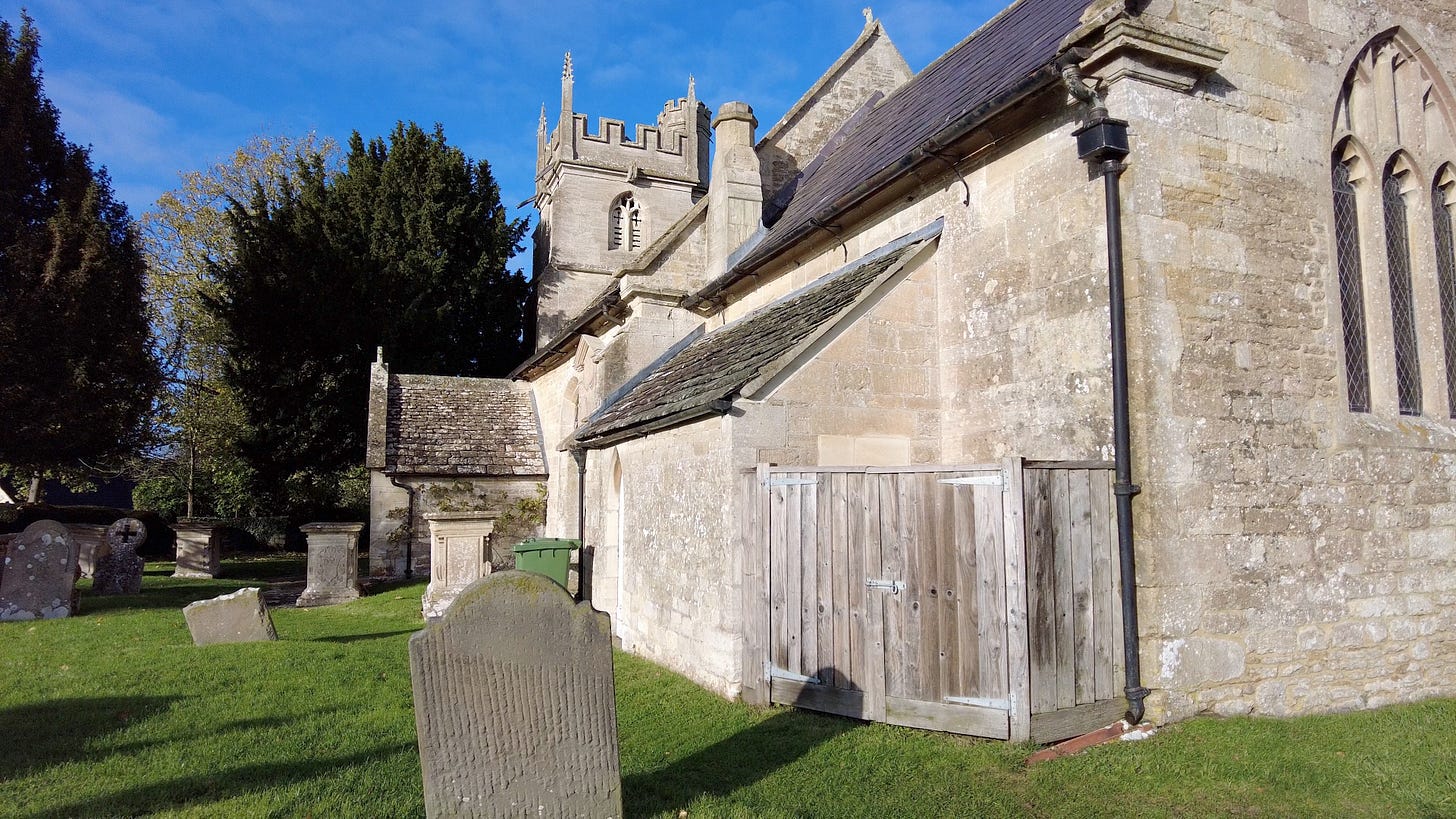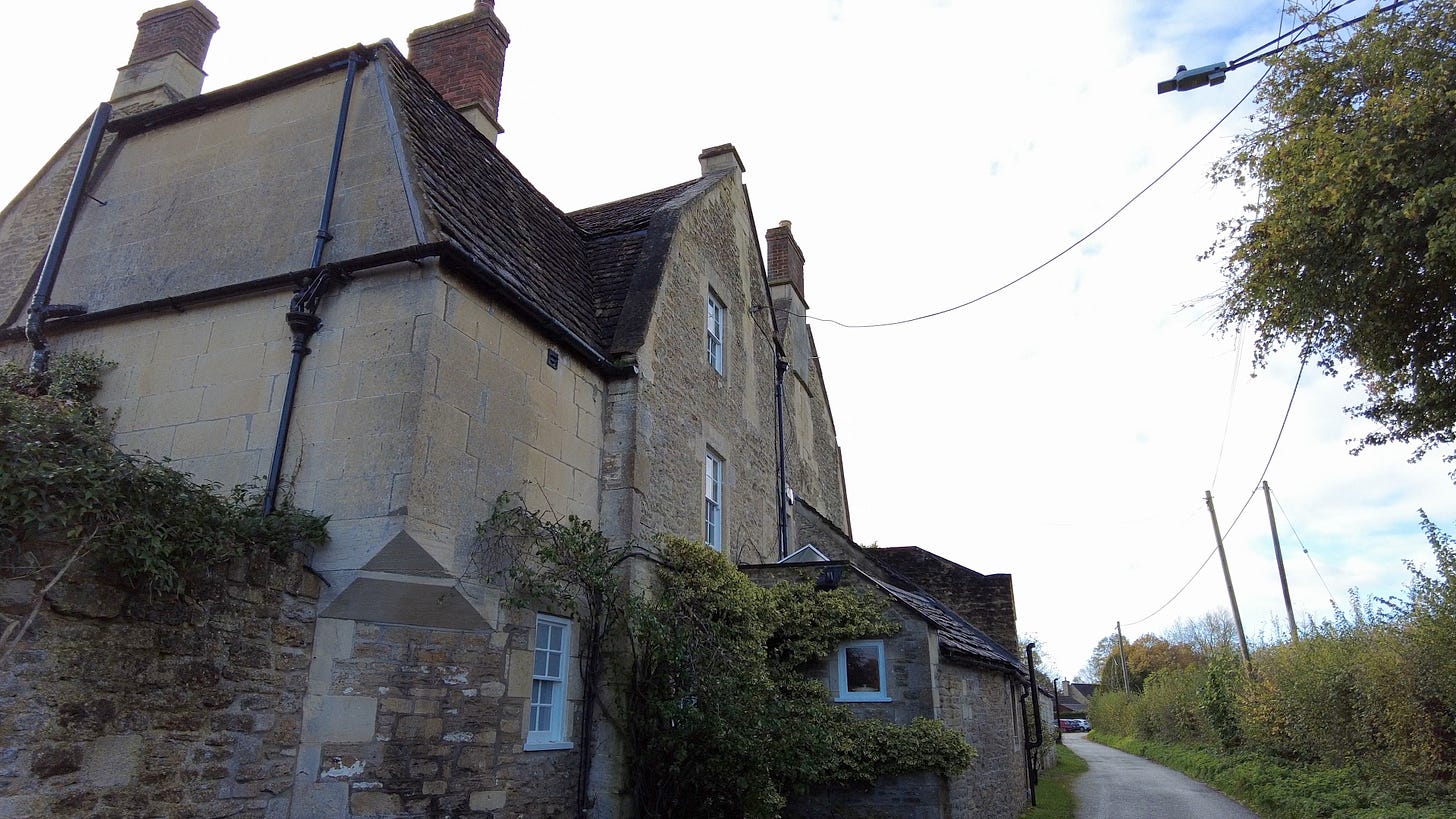Wingfield, Trowbridge
I live very close to the Wiltshire village of Wingfield. If the road had a footpath, walking there wouldn’t take long. However, it’s a road with some bends at the start, and the traffic moves quickly, a recipe for pedestrian disaster! The village is small, and like many places, its size belies its history.
Wingfield is under 2½ miles west of Trowbridge. Motorists will tend to know it for the crossroads controlled by traffic lights known as Wingfield Crossroads. The road from Trowbridge is the old London to Wells road, and the road crossing over this is the Bradford on Avon to Rode Turnpike.
Wingfield has been inhabited for a very long time. Its name is derived from the field belonging to an unknown Saxon settler with a name something like Wine or Wina. It is recorded in the Domesday Book (1086) with the name Winefel, and during the 19th century, later it was often spelt as Winfield or Winefield. During the 19th century, it became known as Winkfield or Winckfield, having the ‘k’ replaced with a ‘g’.
The village appeared to have developed around the church and the common land, which was inclosed from 1822-23. Today there are approximately 350 inhabitants.
Wingfield Crossroads
I start my walk at the crossroads. On one corner is a wooden crucifix and a carved image of Jesus Christ, replacing a bronze statue stolen in 2014. The 100-year-old bronze was valued at £10,000. This is where you can find the roll of honour for those killed in the First World War.
On the opposite corner of the memorial, lying behind a high hedge and trees is Wingfield House. Construction of this home began in the 18th century and was added to in the 19th. It became a hospital during WWl, as did many large homes. From 1935-1938 it was used as a home for waifs and strays and accommodated up to 30 boys. Calling children waifs and strays today seems very alien, yet it isn’t that long ago. Thankfully views have changed, although it could be argued that many children are no better off under the current care system. The house was requisitioned once more during WW2 before being handed back and turned into four homes.
Heading towards Trowbridge, there are a couple of lanes on the left, Loves Lane and the drive to Trowle Farm, built in the 17th century. Going in the opposite direction towards Farleigh Hungerford, there are a few older properties on the right, and further along the road is Magdalen Lane, where several newer homes lie on its right-hand side.
The Poplars Inn, Wingfield
On the main road heading towards Rode, close to the crossroads, is Pomeroy Lane, named after Pomeroy Manor (long gone), leading to several properties and a large farm. However, I want to concentrate on Church Lane, which we will come to as we journey along Frome Road. Just before reaching Church Lane, there is The Poplars Inn on our right and Shop Lane. This pub is a former farmhouse and is Grade 2 listed. It has been a pub for a long time, but I can’t find an exact date. In 1796, an objection was raised to the granting of a licence for a public house by the magistrates.
It is unusual in that it has a cricket pitch on its grounds. Due to the close proximity to the road, if a ball is hit for six, the player gets the points but is immediately out.
From 1880 until the 1920s, it was run by George Tucker Couch, who died in 1923 and is buried in the churchyard. It was sold the following year to Wadworth’s Brewery of Devizes and had been owned by the same family, the Huntleys, for 57 years. Sales particulars of 1924 list several outbuildings described as a stable coach house, a cow house with a boiler, a pig sty and others. It occupied two acres and was described as the only public house in Wingfield. The particulars also state the property included a grocery store, and maybe that’s why the lane is called Shop Lane.
Church Lane, Wingfield
Church Lane, as mentioned earlier, is where the village mainly developed. Church Lane contains a mixture of old and new homes. The village school is still going and has been open since 1852. It’s nice to see that the local children haven’t been forced into one of the schools in Trowbridge.
At the end of the lane lie three properties worthy of mention. Church Farm, a late 15th-century hall house, is at the furthest point of the lane. The main building has encompassed that and has a date inscribed on it, 1636. My research shows that the interior has been modernised but retains a 16th-century stone fireplace and several 17th-century oak-panelled doors with solid moulded frames and their original hinges. Extending beyond the west end of the south front is a doorway very similar to the porch, which seems to indicate that the original building has been shortened. The agricultural buildings surrounding the farm have been converted into residential dwellings.
The Church of St Mary, which is next to the farm, is from the 15th century with later additions. Just the west tower and the chancel arch survive from that period. It had a makeover in 1732, and the nave was made with a Georgian round-arched window. In 1861 the transept was added. On the side of the church, there are two memorials. One is a plaque to Sir James Tillie 1647-1713, who descended from yeoman farmers, a class below the gentry but above the average working person. James did well for himself and, in 1673, was a law student in London. He was made a Knight Bachelor on January 14th 1687, a term meaning he was knighted but not inducted as a member of the organised orders of chivalry.
The other memorial cartouche, which is barely legible, is believed to commemorate the Ballard (Bailward) family. They were wealthy clothiers in the area. The church has lovely open views across the countryside. The Rectory next door, sold in 1969, is now a private home with a few tales to tell.
The house was largely rebuilt for the Reverend Edward Spencer from 1797-1819. It was here that he held a school for up to 30 boys. One of the pupils was the English Essayist and critic Thomas de Quincey. Thomas was famed for his book Confessions of an Opium Eater. This was a study into his addiction to opium and its psychological effects. Another pupil was Edward Grinfield (1785–1864) biblical scholar and author. He became minister of Laura Chapel (demolished early 1900s), in nearby Bath, before moving to London. He died at Brighton on 9 July 1864 and was buried in Hove churchyard.
There is a lane called Chapel Lane, running parallel to Church Lane. Records show the chapel seated 150 persons. It was built in 1896 and was often referred to as a “village station”. The chapel was sold in 1983, and I have to assume that the private home Chapel House, tucked out of sight of the lane, was the chapel.
If you want to take a video tour of Wingfield, click this link to see my YouTube video.
There are a few more interesting accounts to relate about Wingfield and this area which I will save for another day. Depending how much I can find out and gain access will dictate when I can add these to Roland’s Travels. Make sure you are a subscriber, and you will be updated!
Would you like to get information really fast without reading an entire book? Try Blinkist and see how you can!
Powerful ideas in 15 minutes
Join now and start up-levelling your small talk game. Get access to over 5,000 book titles alongside 20 million other readers.
Save 25% on a Premium Subscription Powered by Swapstack
















Thank you Roland for this information on Wingfield. I enjoyed finding out the history of Wingfield, which I had not known before. As a family coming from Italy to England my father found a job on that farm and we lived in a bungalow near the farm. I went to the little school there and was taught how to speak English. (Wiltshire English)!!! Those days were happy days to what they are now.